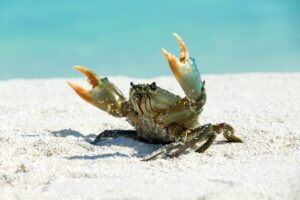The nights plunge into darkness early in St. Lucia. Being only 14 degrees north of the equator means fierce tropical heat but not a huge axis tilt to produce longer days. But on this particular night, the sky was lit with stars and a crescent moon set the ocean ablaze, providing my husband, Patrick, with just enough light to see where we were going as we dropped down dark, unlit roads that bent like the hook of an anchor. We were on our way to the tiny fishing village of Anse La Raye for Seafood Fridays.
This is a big event on the island, as it is on any island, really — people come into town from the valleys on payday to celebrate the end of the long, hot work week. The women of Anse La Raye had risen at dawn to begin seasoning the fresh fish brought in by the boats in the harbor, filling their chaffing dishes with rice and peas, papaya gratin, macaroni and cheese and conch soup. For hours they’d been lugging their grills and coolers of icy cold Piton beer to the main road, setting up folding tables and chairs for the festivities.
We’d spent the early morning hours scrambling over boulders on our way to the top of Gros Piton, the St. Lucia mountain that shoots sharply from the sea, and our afternoon scouring the ocean floor during a dive, lazily following golden spotted eels as they slithered through the sea grass. We finished our dive after watching a seahorse bob in and out of the same grass, then headed for the shower to change for dinner. It hardly seemed fair — the women were doing all the hard work, while we were about to reap the rewards.
“Wrong way!” locals cried as we passed them in the car, thinking that we were headed to one of the island’s high-end resorts. But I could smell the sea wafting from the women’s pots and billowing off the grills of the street stalls. After successfully navigating our way down the narrow streets with lethal drops into the gutters, we parked beside the red-roofed stone church that stood out as the sturdiest structure in this wood-shack town painted the bright Caribbean colors of yellow, green and blue. Timber boards flaked with the wear of salt water and wind separated life on the street from life in a Caribbean family home, where women raised their children.
But tonight, the women weren’t in their homes. They were in the street, standing under tents behind long plastic tables laden with the food they’d spent all day preparing. Chaffing dishes filled with mahi stewed to tender with more garlic than I thought possible sat beside dishes of prawns sautéed in spices and bowls of coleslaw. Bright coral-colored spiny lobsters sizzled over a fire beside whole red snappers stuff ed with thyme and lemon.
“What’s that one?” Patrick pointed to a vat of grey liquidy stew. His plate was already piled high. Miss Merna, a large woman with short tight curls, laughed. “You don’t want that one.” Never one to shy away from a culinary challenge, he asked again, “What is it?” She ran a hand from her sternum to just below her belly button: “Fish insides.” Patrick paled a similar color to the murky gruel. “I think I’ll stick with the snapper.” Merna laughed as she spooned a vinaigrette-like sauce of minced peppers and herbs over our snapper. “Most visitors do.”
Loud music filled the street and a couple performed their own version of twerking as we sat down at a picnic bench behind the line of food. “Whew!” Miss Merna fell into the plastic chair beside me. She removed her glasses and began to polish them with her white apron. “It’s going to be a good night.” As the music increased in volume I devoured the fish.
The sauce was piquant: Scorching scotch bonnet chilis competed with the tang of lime for dominance. It was well-rounded and set the moist fish aflame with flavor. It was good. Real good. “This sauce is amazing.” I said to Merna, my voice raising above the music and struggling to be heard. “What is it?”
“An island dressing.” My face screwed into disbelief. “Thousand Islands?” I was confused by the description and not sure I’d heard her correctly. “Not a thousand islands, baby.” Her laugh floated over the music and pierced the night. “Just this one.”
Red Snapper Souscaille
For the Souscaille:
- ¼ cup coconut oil
- 4 cloves garlic, minced
- 1 cup red onion, diced fine
- 2 cups yellow pepper, diced fine
- 2 cups red pepper, diced fine
- 2 poblanos, diced fine
- 1 scotch bonnet, minced
- 1 teaspoon sea salt
- 1 teaspoon ginger, grated
- 4 green onions, green portion minced
- 3 limes, juiced
- 1 orange, juiced
- 1 teaspoon sugar
- 2 tablespoons parsley, chopped
- 2 tablespoons cilantro, chopped
- ¼ cup olive oil
For the Fish:
- 6 red snapper fillets
- 1 teaspoon sea salt
- 1 teaspoon Caribbean curry powder
- 2 tablespoons coconut oil
- 2 limes, juiced
Make the Souscaille: Saute the garlic and red onion in a large frying pan with the coconut oil over medium- high heat for 5 minutes, until the onions soften. Add the yellow, red, and poblano peppers, scotch bonnets, sea salt, and ginger, and sauté an additional 5 minutes, until peppers begin to release their juices. Add the green onions, lime juice, orange juice, and sugar. Simmer for 2 minutes and remove from heat. Stir in the parsley, cilantro, and olive oil. Set aside while you cook the fish.
Cook the Fish: Preheat the oven to 350 degrees. Sprinkle half the sea salt and all the curry powder over the presentation side of the red snapper. Heat a large frying pan over medium-high heat. Working in batches and being careful not to crowd the pan, sauté the fish in the coconut oil, presentation side down, for 2 minutes. Season the bottom of the fish with sea salt. Place, presentation side up, on a baking tray that has been coated with cooking spray. Repeat with remaining fish fillets. Squeeze lime juice over the fish. Place the tray in the oven and bake for 5-10 minutes until the fish is cooked through.
Assemble: Place a fish fillet in the middle of the plate. Spoon the souscaille over the fish and serve.





